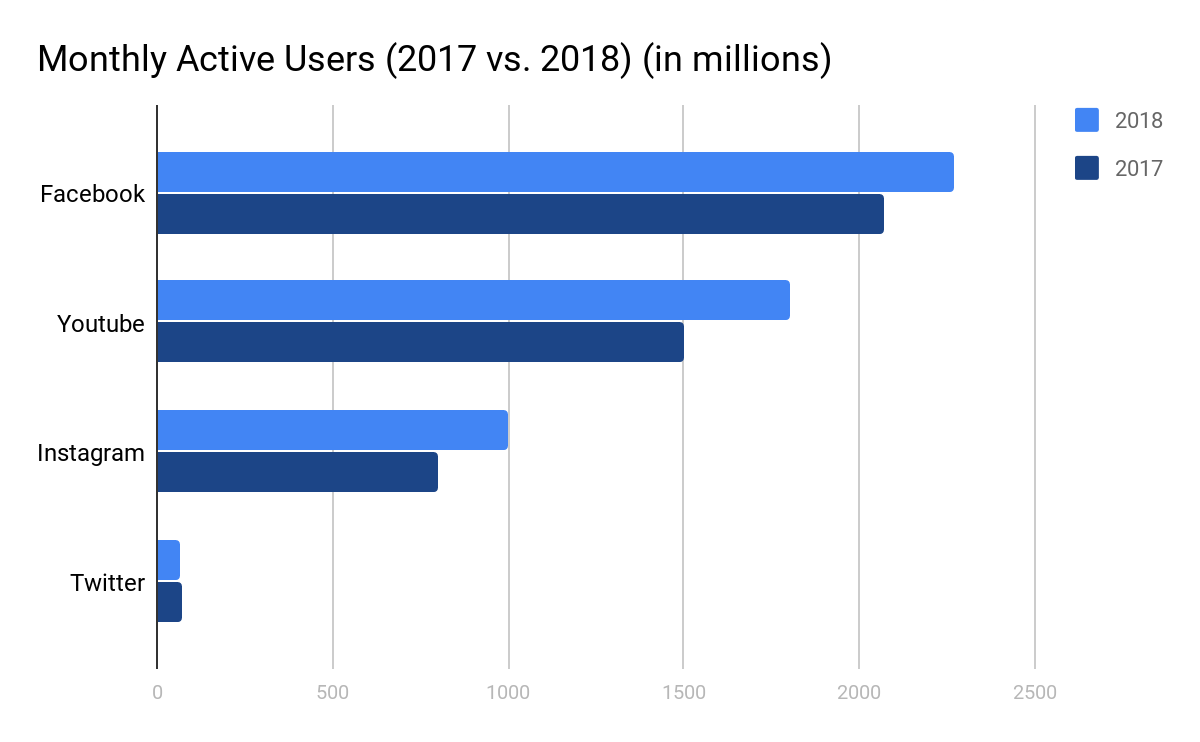We thought we’d look back at the highs and lows of 2018 and share with you some stats about last year’s internet performance, and discuss a potential trend for this year.
Browser Usage
First, we’ll look at which browsers were most popular in 2018. Chrome remained on top of the market and has grown even further since 2017. Safari picked up speed while Firefox fell from 6% to 5%. Internet Explorer continued dropping to 2.87%, which means it’s surprisingly used more often than Microsoft’s latest browser, Edge (2.08%)!

Device Usage
Mobile devices are still the primary portal to the internet, and increasingly so. If your website wasn’t responsive or you weren’t monitoring your website’s responsiveness in 2018, you’d better get it ready in 2019! Mobile devices sustained a seven point lead over desktops for almost the entire year.

Monthly Active Users
People are using the internet more than ever, connecting, sharing, and experiencing the world together. Here’s how the active users of each major social network stack up:
- Facebook continues to grow, reaching a staggering 2.7 billion monthly active users as of the third quarter of 2018.
- YouTube is not far behind with 8 billion monthly logged-in users as of May 2018.
- Instagram follows with 1 billion users as of June 2018.
- Twitter stays relatively quiet with only 67 million monthly active users (as of the third quarter of 2018), down 2 million since 2017.

Screen Resolution
Screens are our window into the digital world. The size and shape of screens that we use directly impact our experiences on websites and apps. For this reason, it’s essential for web designers and developers to tailor as well as monitor website and app digital experiences to ensure they look great on every common screen size. Let’s “look into” the statistics for screen resolution in 2018:
Overall, we see a slight shift towards higher resolution screens in 2018, particularly 1080p which is also known as HD. It’s trending up from only 7.57% in 2017 to 9.43% in 2018. As people buy new computer displays and phones, we’re likely to see these larger resolutions continue to increase in popularity.
360×640 is the most popular because so many people use mobile phones to access the web. High density screens often just use a multiple of this base resolution, showing content at 200% or 300% density (which is equivalent to full HD). Also, most screens use an aspect ratio of either 16:9. Despite 1366×768 being a very popular resolution (especially for laptops), it can actually cause problems because it is not truly 16:9. Technically, this resolution is 16:8.9956076.
2018 Ups and Downs
We have some amazing data to share from SolarWinds® Pingdom® website performance and availability monitoring solution:
- There were 165 million outages, representing over 3 billion collective minutes of downtime. That’s enough time to walk from Earth to the asteroid belt!
- We sent approximately 49 million “down” alerts and over 45 million “up” alerts.
- We sent about 150 million individual alert messages across email, SMS, and chat. That would be a stack of paper almost six miles high!
- You might find it interesting to see real-time internet status with the SolarWinds free tool, Live Map.
More Statistics
- Google is now handling over 1.2 trillion search queries per year—an average of 40,000 searches per second.
- Internet domains have reached 339.8 million registrations, as of the end of the second quarter of 2018.
- There are over 1,930,000,000 active websites on the internet as of November 2018.
- Make sure your website loads fast! A 1-second delay on page load can cost you 7% of your ecommerce conversions.
- By this year (2019), it is estimated that there will be 224 million digital shoppers in the United States alone.
- Over 1.2 billion MWh of electricity was used in 2017 to power the internet.
- Nearly 2 zettabytes of internet traffic was processed in 2017. That’s two trillion gigabytes… over 30 billion iPhones worth of data!
Are Progressive Web Apps the Next Trend?
Responsive web design is reaching maturity with 87% of digital experience makers embracing it, so what is the next upcoming trend to improve user experience online? That next trend may end up being Progressive Web Apps (PWAs). These types of apps provide a native-like experience that integrate with your device’s OS features but run through your browser. They can be launched from the Start menu and look just like other installed software.
Browser support for PWAs solidified in 2018, as service workers are now supported in Microsoft Edge, Google Chrome, Mozilla Firefox, and Safari. Also, with Chrome 70 released this year, desktop PWAs are now supported for Windows and Linux.
The days of big installations and long load times might be a thing of the past. For example, Tinder cut down their loading time from 11.91 seconds to just 4.69 seconds with their PWA! The file size of their PWA is also a whopping 90% smaller than their native Android app. The future of apps is very bright with this new PWA technology!
Load times and page speed are critical with today’s demanding, impatient users. Your competition is a click away if you don’t serve up a great web experience. With Pingdom, you know about web performance issues before they impact your users with features like Page Speed Monitoring, Transaction Monitoring, and Real User Monitoring (RUM).
Thank You for 2018
Let’s make 2019 the year of a faster and more reliable internet. If you’re not already monitoring your website’s availability and performance, why not see what SolarWinds® Pingdom® can do?


























